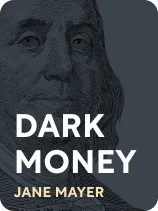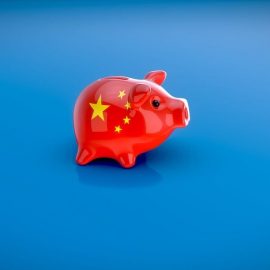

This article is an excerpt from the Shortform book guide to "Dark Money" by Jane Mayer. Shortform has the world's best summaries and analyses of books you should be reading.
Like this article? Sign up for a free trial here.
Who’s Richard Fink? What’s his relationship with the Koch brothers? How did he help them wield their political influence?
According to journalist Jane Mayer, Charles and David Koch used their fortunes to propagate far-right ideology in American politics between the 1970s and 2016. Richard Fink is the advisor who devised their strategy.
Continue reading to learn about Richard Fink’s plan to influence American politics.
Richard Fink’s Plan
Before we can understand Richard Fink’s plan, we must look at the background that necessitated it. While the Kochs felt motivated to enter politics in the 1970s, they struggled to gain traction. In 1980, David Koch ran for vice president on the libertarian ticket on a platform that mirrored the Freedom School’s curriculum. It called for the abolition of Medicare, Social Security, the EPA, income tax, child labor laws, public education, and essentially every government service except the enforcement of property laws. The campaign failed, receiving just 1% of the vote.
(Shortform note: The libertarian party is currently the third-largest political party in America. However, the Democratic and Republican parties still dominate American elections to the degree that the greatest percentage of the vote that a libertarian presidential candidate has received is just over 3%, which went to Gary Johnson in 2016. The libertarian candidate for president in 2020, Jo Jorgenson, received just 1.2% of the vote.)
Taking a lesson from this, Mayer explains that the Kochs decided to keep their political influence at the funding level instead of running for office themselves. They began devoting their fortune to front groups that presented the government as the enemy of the people and believed that the purpose of the nation should be to enable private citizens to accrue immense wealth.
(Shortform note: In recent years, Charles Koch has expressed some regret over his heavily partisan participation in the political sphere. He’s begun trying to reach across the aisle and appeal to liberals and Democrats on criminal justice reform and foreign affairs in order to bridge the ideological divide in America he feels he helped create. However, the vast majority of his political spending continues to go to Republican candidates.)
To this end, Charles Koch hired Richard Fink as his political advisor. According to Mayer, Fink laid out a specific plan consisting of three phases for taking over American politics. These three steps were 1) invest in conservative intellectuals who could produce the ideas for the movement, 2) invest in think tanks to market these ideas as policies, and 3) create groups that supposedly represented the will of the people to pressure politicians to adopt the policies.
(Shortform note: Some argue that the Trump presidency called into question the necessity of hiring political advisors like Richard Fink to win races or achieve political victories. Trump’s campaign was highly unconventional, and his win defied the predictions of professional pollsters, making it seem that perhaps political success isn’t contingent on having expert advisors. Still, it’s unlikely that politicians will dispense with advisors, simply because the politicians are so eager to win: It seems more sensible and less risky to just hire an advisor, even though you can’t truly know how helpful they’ll be to your campaign.)
Phase 1: Produce Conservative Ideas
To carry out phase 1, explains Mayer, the Kochs sought to establish a beachhead, or a program at a prestigious university that they could fill with conservative-minded faculty and then grow into much larger programs. Such programs were given deliberately innocuous names to avoid the appearance of being ideologically driven.
They did so at Virginia’s George Mason University, where they established the think tank called the Institute for Humane Studies, a program aimed at building a new generation of libertarian scholars. The libertarian emphasis of the program was so heavy that at one point applicants’ essays were scanned by computers for mentions of libertarian icons like Ayn Rand. This, as well as the funding of other think tanks like the Cato Institute and the Heritage Foundation, created the intellectuals who would produce ideas for the libertarian movement.
(Shortform note: Today, the Institute for Humane Studies continues to fund research supporting libertarian ideas, offering $2 million in grants for scholars as well as tens of thousands of dollars in fellowship grants. As part of their talent identification rubric, the program assesses potential applicants for their openness and sympathy to the ideas of classical liberalism—which are comparable to libertarian beliefs—and notes this as their most essential measure for accepting applicants.)
Phase 2: Market Conservative Policies
For phase 2, the Kochs established the Mercatus Center, also at George Mason University, which critics described as nothing more than a lobbying group. Conservative faculty members wrote drafts of bills for issues like supply-side tax cuts that were then passed on to legislators to introduce into Congress. According to Mayer, such programs led these previously far-right ideas to be taken seriously in politics and to begin affecting legislation, just as Fink had planned.
(Shortform note: The Mercatus Center remains one of the country’s most influential libertarian think tanks. Though it officially represents itself as a nonpartisan group that doesn’t engage in lobbying, critics have noted that the group has spent hundreds of thousands of dollars on trips for government officials and suggested that it should be required to register itself as a lobbying group. Funded by millions of dollars from Koch Industries, the center also provides money and benefits to conservative media figures such as FOX News contributor Larry Kudlow.)
Phase 3: Apply Popular Pressure to Influence Politicians
Finally, for phase 3, Charles Koch established the nonprofit educational group Citizens for a Sound Economy, which would act as a sales force to build public support for their libertarian ideology. This group had the appearance of a grassroots movement. But, in reality, it was funded by corporate sponsors, mainly the Kochs. Rather than being made up of average citizens fighting for what they believed in, Mayer writes, it was instead run by pro-capitalist businessmen who would use the group to promote their own interests.
Over the next few decades, the Kochs repeated this pattern at hundreds of other universities and think tanks.
(Shortform note: In 2003 Citizens for a Sound Economy disbanded and split into two groups: Americans for Prosperity and FreedomWorks. FreedomWorks played a significant role in the fight against climate legislation and continues to downplay the impact of climate change, citing it as a “woke” political grab by the Democrats. This might be considered evidence that the group is indeed run by business people who don’t want climate change legislation to hamper their money-making efforts.)

———End of Preview———
Like what you just read? Read the rest of the world's best book summary and analysis of Jane Mayer's "Dark Money" at Shortform.
Here's what you'll find in our full Dark Money summary:
- How a group of wealthy individuals has legitimized far-right beliefs in America
- A look at Charles and David Koch's views and tactics
- The influence dark money has had on American politics and society






